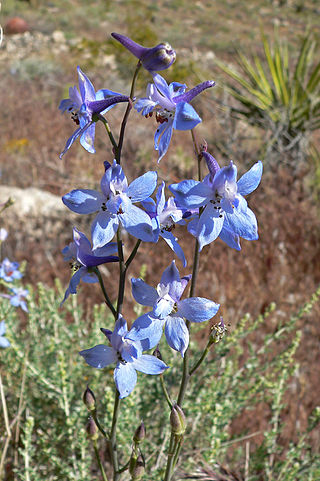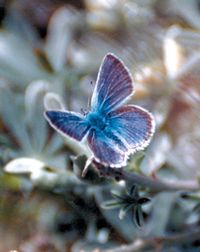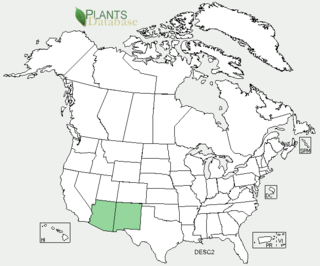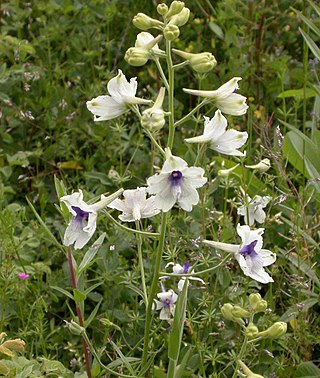
Delphinium is a genus of about 300 species of annual and perennial flowering plants in the family Ranunculaceae, native throughout the Northern Hemisphere and also on the high mountains of tropical Africa. The genus was erected by Carl Linnaeus.

Delphinium parishii, the desert larkspur, is a flowering plant in the family Ranunculaceae native to the Mojave Desert, in the southwestern United States and northwest Mexico. In Southern California it is also found in the Tehachapi Mountains, Transverse Ranges, and eastern Sierra Nevada.

The Mission blue is a blue or lycaenid butterfly subspecies native to the San Francisco Bay Area of the United States. The butterfly has been declared as endangered by the US federal government. It is a subspecies of Boisduval's blue.

Acanthomintha duttonii is a species of annual plant endemic to San Mateo County, California in the family Lamiaceae. It is commonly called San Mateo thornmint and is found growing on serpentine soils near the Crystal Springs Reservoir in a six-mile (10 km) long strip on the east side of Montara Mountain at elevations of approximately 150 to 300 meters.

Delphinium patens is a species of larkspur known by the common names zigzag larkspur and spreading larkspur. It is a wildflower limited mainly to California. Though not yet confirmed there, it is expected in Baja California. Plants grow typically 20 to 50 centimeters tall and bear up to 36 flowers each. The stems are mostly hairless, have reddish bases, and bears leaves on the lower half. Each leaf is divided into 3 to 9 lobes. The flower has dark blue sepals, the latter ones reflexed. The spur at the back of the flower is 4 to 8 millimeters long. The cleft at the center of the flower has white or yellowish scattered hairs. The elongated fruit is one or two centimeters long and contains pitted seeds.

Delphinium cardinale is a species of larkspur known by the common names scarlet larkspur and cardinal larkspur. This wildflower is native to California and Baja California, where it grows on coastal, inland, and desert chaparral slopes, such as the Colorado Desert, and the Peninsular and Transverse Ranges. The presence of diterpenoid alkaloids, probably including the highly toxic methyllycaconitine, in above-ground parts of D. cardinale means that they are likely to be toxic if ingested.
Delphinium decorum is a species of larkspur known by the common names coastal larkspur and yellow-tinge larkspur. This wildflower is native to California and Oregon, where it grows on the slopes of the coastal ranges from the San Francisco Bay Area north to the southern Oregon coast. It has an erect stem which approaches half a meter in height at maximum. The leaves, which are divided into a number of narrow lobes, are mostly located about the base of the plant. The spindly stem above bears two to twenty widely spaced flowers. Each flower is carried on a pedicel several centimeters long. The five long, flat sepals are extended to give the face of the flower a star shape, and they are usually deep blue to purple. The petals are similar in color, except the top two may be lighter to almost white. The spur is very thin and may be nearly two centimeters long.

Delphinium hesperium is a species of larkspur known by the common name foothill larkspur. It is also sometimes called western larkspur and coastal larkspur, but these names are less specific since other species share them. It is endemic to California, where it grows in woodland and grassland in the northern half of the state. This wildflower generally reaches one half to one meter in height. It has deeply lobed, prominently veined leaves, mostly located near the base of the plant. The inflorescence may hold very few to over 100 flowers, each on a long, thick pedicel. The flowers are usually a brilliant blue or purple, and sometimes lighter pinkish to white. Often the sepals are dark in color and the petals lighter. The spur is about one to two centimeters long.
Delphinium hutchinsoniae is a rare species of larkspur known by the common names Monterey larkspur and Hutchinson's larkspur. It is endemic to California, where it is known only from Monterey County. This wildflower reaches a meter in height but is usually shorter. The leaves are divided into lobes which are further divided into smaller lobes, and they are mostly located low on the plant. The top of the thin, erect stem is occupied by an inflorescence of not more than ten flowers. Each flower has sepals which are brilliant purple or blue to lavender, two petals which are the same color, and two upper petals which are usually white. The spur is up to two centimeters long and curves down at the tip.

Delphinium parryi is a species of larkspur known by the common names San Bernardino larkspur and Parry's larkspur. This wildflower is native to Baja California and California from the San Francisco Bay Area south. It is found in chaparral and woodlands and other habitats.
Delphinium purpusii is a rare species of larkspur known by the common names Kern County larkspur and rose-flowered larkspur. It is endemic to California where it is known only from Kern and Tulare Counties in the region where the Sierra Nevada meets the Mojave Desert. It grows on rocky cliffs and talus. This wildflower reaches between one half and one meter in height. The erect thin stem has deeply lobed leaves around the base and a small, narrow inflorescence of generally ten to 20 flowers at the top. The flowers of this species are bright pink, making it unusual among the mainly blue-flowered plants of this genus. The sepals curl either forward or back.

Delphinium polycladon is a species of larkspur known by the common name mountain marsh larkspur. It is native to the High Sierra Nevada and the White and Inyo Mountains of eastern California and far western Nevada, where it grows in wet sites in the talus. It is a perennial herb producing one or more erect stems which easily exceed a meter in height but often remain dwarfed in high-elevation, exposed habitat with thin soils. The leaves are small and mostly located near the base of the plant. The inflorescence is a raceme of up to 35 flowers on long, S-shaped pedicels, often arranged along one side of the stem. The sepals are deep blue to purple, one to two centimeters long, and with a spur up to 2 centimeters in length.
Delphinium umbraculorum is a species of larkspur known by the common name umbrella larkspur. However, its epithet does not denote an umbrella. Instead, it describes the habitat of this plant, usually shady and cool places. It is often confused with D. parryii which has similar flowers and D. patens which has similar stems and leaves. It is endemic to California, where it grows in the woodlands of the coastal mountain ranges from Monterey to Ventura Counties. It is a perennial herb producing an erect stem 40 to about 80 centimeters tall. The hairless leaves are located at the base of the plant and along the stem as well. The inflorescence bears several flowers with reflexed dark blue sepals and a spur over a centimeter long. The fruit is between 1 and 2 centimeters long.

Delphinium scopulorum, commonly known as Rocky Mountain larkspur, is a species of wildflower in the genus Delphinium, which belongs to the buttercup family, Ranunculaceae. It is native to the Southwestern United States and found predominantly in upper-elevation moist meadows.

Delphinium pavonaceum is a species of flowering plant in the buttercup family known by the common name peacock larkspur. It is endemic to Oregon in the United States, where it is limited to the Willamette Valley.
Delphinium viridescens is a species of flowering plant in the buttercup family known by the common name Wenatchee larkspur. It is endemic to central Washington state in the United States, where it occurs in the Wenatchee Mountains in Chelan and Kittitas Counties.
Delphinium robustum is a species of flowering plant in the buttercup family known by the common names Wahatoya Creek larkspur and robust larkspur. It is native to Colorado and New Mexico in the United States.

Delphinium barbeyi is a species of flowering plant in the buttercup family known by the common names subalpine larkspur, tall larkspur, and Barbey's larkspur. It is native to the interior western United States, where it occurs in the states of Arizona, Colorado, New Mexico, Utah, and Wyoming.

Delphinium exaltatum, known by the common name tall larkspur, is a species of flowering plant in the genus Delphinium, part of the buttercup family. Other Delphinium species are also commonly known as tall larkspur, such as Delphinium barbeyi. D. exaltatum is native to the central and eastern United States, where it can be found in Kentucky, Maine, Ohio, Pennsylvania, Maryland, West Virginia, Virginia, North Carolina, Alabama, Tennessee, and Missouri.

Acanthomintha ilicifolia, known by the common name San Diego thornmint, is a rare species of flowering plant in the mint family. It is native to Baja California and San Diego County, California, where it is a resident of the chaparral and coastal sage scrub plant communities and vernal pools.















